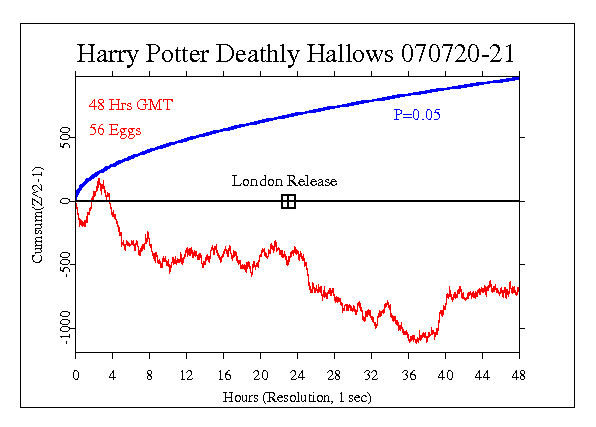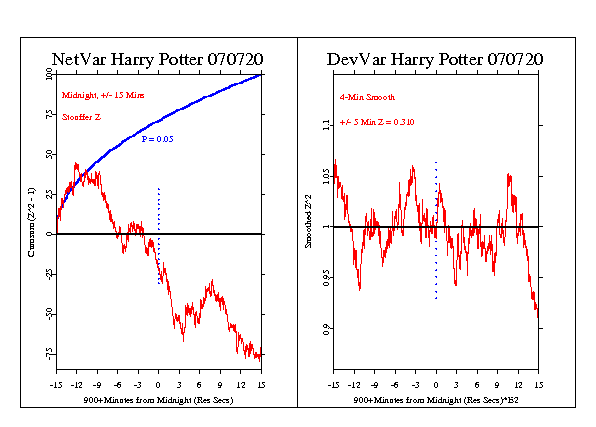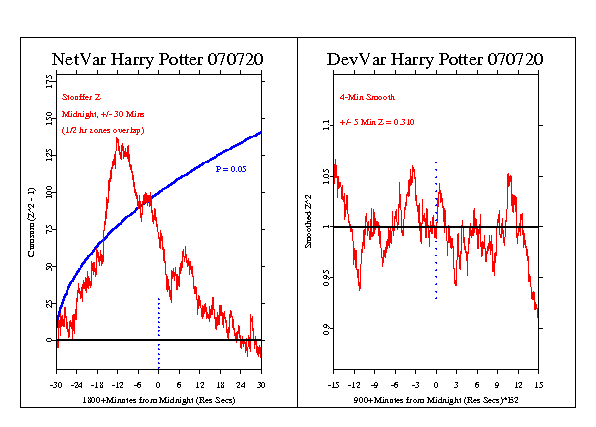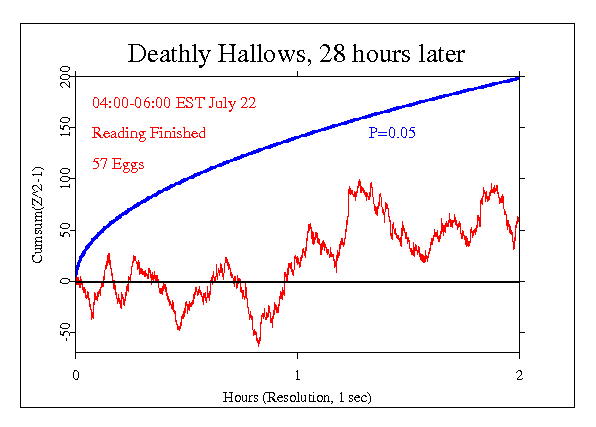Harry Potter: Deathly Hallows Release 20 July 2007 |
|
About a dozen people suggested that or at least wondered if the release of book number seven in the Harry Potter series, Deathly Hallows, would be worth looking at as a global event. Some went much further, proposing that this was such an important moment in consciousness space that it must be a test of the GCP concept. David Thomson said, "If I have the right bead on the Harry Potter phenomena, the whole planet has just experienced a major shift in consciousness. This myth has become a global myth and will affect the structure of human conception from here on out. Rowling has written a successful mythology on the scale of the Egyptian, Greek, and Roman gods. Kids everywhere are taking this in, and they will grow into the adults of tomorrow. Future generations from all cultures will read Harry Potter." David felt my assessment of the significance of this event was deficient (I had suggested it was not in the same league with "things like Brazilian plane crashes, the ongoing tragedy of Iraq and increasingly, Afghanistan, [or] more promising major events like discovery of the huge underground lake in Darfur, ...." which were competing events on the world stage around this time.) He also assumed I would not be looking for a significant effect, and may have been concerned it wasn't on my agenda since I thought the event was hardly earthshaking. In general, I am more interested in learning something than proving a point, and I had indeed planned to look in on the newest, and last, of Rowlings' Harry Potter books. Interestingly, the same contretemps over the status of a Harry Potter release vis-a-vis the GCP ran its course two years ago on a list for professional researchers, devolving eventually into a discussion of experimenter psi as an explanation for GCP effects. I take a portion from the 2005 page:
Here's a picture of the NetVar measure (Cumulative Z² - df) for the
20th and 21st of July, GMT. The opening at midnight in London is marked.
This result is reminiscent of that in 2005, and though it is
not signficant, the trend is persistent, and fairly
persuasive. It is perhaps noteworthy that the trace reverts
to a random walk during the last segment, much as
it did in 2005. Again,
whether the trend has anything to do with the Harry Potter release is
a question we can't answer, as suggested above. More to the
point technically, the S/N ratio in the GCP formal effects
is tiny -- the average effect size per event is equivalent
to Z = 0.5, meaning it takes many replication to achieve
reliable statistics. If you are unfamiliar with GCP analysis,
there is information about the graphical
displays and an introduction to interpretation
of the analysis, which, although it was written for
meditation events, is generally applicable.
But the better test of Thomson's contention that
"The extreme popularity and strong emotional effect of this
series has got to rate among one of the most significant world wide
events in a while" might be the synchronized release at
midnight around the world, focusing the interest locally.
As before, we use signal averaging to look at a pair of
graphs of the data around midnight. There is
a suggestive trend around the stroke of midnight for the Stouffer
Z² - 1, but it happens to be of opposite sign to that
from 2005. The variance around midnight looks random (in contrast to New
Years, where the signal averaged midnights exhibit a
significant drop in variance centered on midnight).
A broadened
time window for the NetVar measure is shown in the next figure.
The result is interesting, and should be instructive in the
sense that it displays very clearly the vagaries of random
data that just might be affected by the excitement
surrounding big social events like the Harry Potter
phenomenon. The trend is strongly positive for a 10 or 15 minutes
and then reverses, to assume an equally strong negative
slope. This should help reinforce the understanding that
single events, and post facto explorations cannot be interpreted
as evidence for (or against) an effect of the Harry Potter excitement.
In addition to the conviction that the Deathly Hallows release would be a significant event, David Thomson was also convinced that when large numbers of people finished reading the book some 28 hours later there would be another surge of "global consciousness". For exploratory and instructional purposes I requested a sufficiently detailed prediction to do an analysis, and he proposed a 2-hour period from 04:00 to 06:00 in the Eastern time zone of the US. The following graph shows the data during this time. It is a good example of a random walk.
While all the caveats about interpretation of any given
analysis pertain, this result is consistent with my
expectation. There is little likelihood that very large
numbers of people would be engaged in a communal, coherent
state of consciousness as a result of finishing the book
around this time. Though the Harry Potter
phenomenon is powerful in its own right, it isn't the kind
of event that engages people in a shared frame of mind.
Reading such a book more likely engages people in their own
individual responses and personal reactions.
That's not what global consciousness is about.
|



